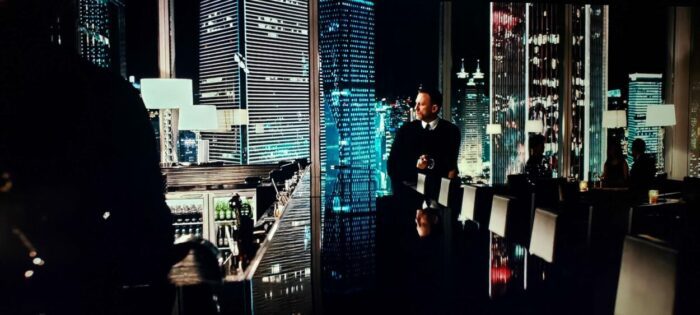When done right no one notices cinematography. They simply absorb the world on screen because it’s more alive. That isn’t to say it’s unnoticeable. Rather, the view remains consistent from start to finish. Good cinematographers designed a view to assist the storytelling, not take away attention. This can mean lots of things, but besides creating a visual tone, cinematography can help accentuate things, making simple moments more metaphorical.
Imagine noir without the chiaroscuro lighting, Bladerunner without the cyberpunk color palette, or Boogie Nights without its quick pans and long takes. Suddenly they seem less interesting. That’s the powerful potential of quality cinematography.

James Bond has a long history, whether in books or film, of glamorous escapism. Granted, these imaginings skew more towards outdated male fantasies; however, that doesn’t change the stylistic intent of each work. And while that doesn’t excuse the misogynistic and nationalistic facets of this flawed character, Double O Seven has always existed in a heightened alternate reality. Something that best comes across visually in the film Skyfall.
Released in 2012, it’s the twenty-third movie in the James Bond franchise. Starring Daniel Craig, Judi Dench, and Javier Bardem, Skyfall brought on Sam Mendes to direct his first 007 feature. With him came cinematographer Roger Deakins. The two having previously worked together on Jarhead (2005) and Revolutionary Road (2008).
By then, Deakins was already a nine-time Oscar nominee with a variety of films under his belt. He crafted the visual aesthetics of movies like Nineteen Eighty-Four (1984), The Big Lebowski (1998), True Grit (2010), The Shawshank Redemption (1994), and would go on to do optically entrancing films like Bladerunner 2049 (2017). Furthermore, his use of bleach bypass in 1984 would ultimately inspire similar stylization in features such as Seven (1995). Having that broad spectrum of experiences, composing the visuals for westerns, dystopian dramas, and quirky noirish comedies gave Deakins a very versatile eye.

In what could be called the Daniel Craig era, the adventures of the most well-known spy took an interesting turn. Starting with Casino Royale (2006), there’s an attempt to feature a more humanized individual. One experiencing a real psychological and physical toll as the movie unfolds. It’s one of the few Bond films to show him wounded and at times not in control of a situation. Gone is the cool confidence of Connery’s Bond, replaced by an icy juggernaut who just doesn’t know when to quit. This then carried over into Skyfall.
Though the film follows the well-established Bond formula, it also manages to subvert expectations by pivoting at critical points. Skyfall is a film about failure, and no one fails more often than Bond. Spoiler warning, but from the opening action set piece, 007 is almost never victorious. The initial mission ends with him being shot by Eve Moneypenny (Naomie Harris). Seemingly dead, he disappears until a need for his skill set demands the Double O’s resurrection, and even then, he’s not exactly up to the task.
What Deakins manages to do throughout Skyfall is create a world of warm colors and vibrant blacks. There’s a subtle sheen to shadows which keeps them from being dull emptiness. When the light comes, it rarely dominates but rather spills across the darkness, especially when any illumination is colorful. Daylight scenes feature a slate grey tint emphasizing the gritty nature of this reality, while the night is alive with gorgeous tones which are never without their inky cutoffs. Bond is even shot at a distance, making him seem small in relation to the larger world around him.

It’s easy to see Deakins painting a portrait of spy craft through such visuals (accomplished with an ARRI Alexa and enhanced by postproduction work courtesy of EC3). Take as a case in point, Bond’s battle with a sniper. Freshly returned to MI6, 007 barely manages to pass tests qualifying him for field work. Yet, he plunges back into the only life he’s ever enjoyed. Tasked with tracking the hired hitman, Bond follows the target to an office building in Shanghai.
As the assassin enters the building, cinematography enriches the story. The sniper becomes nothing more than a silhouette, a faceless killer literally working in the shadows. Bond pursues becoming much the same. In a vacant unfinished floor, the neon glow of digital billboards stains the darkness blue. It’s like a better world outside inadvertently spilling into the stygian spy realm. Spotting his target, Bond engages. The combatants become nothing more than silhouettes in a life and death struggle. At one point, they’re essentially indistinguishable for a moment, a visual metaphor for how they’re basically the same — killers on their masters’ errand. It’s even possible to lose track of Bond and not be sure who’s getting the upper hand.
Of course, he survives, but the mission isn’t exactly a success. Looking through the broken window the sniper just fell through, we see Bérénice Marlohe as Sévérine. She stands in a lavish apartment awash in warm orange lighting. That world entirely lit, while across the way Bond peers at it, shrouded in shadows he eventually vanishes into — the reality he can only see but never be a part of.

Such cinematographic juxtapositions abound throughout Skyfall. However, nowhere are they more overt than the sniper scene. The moment doesn’t stand out since the film is visually consistent, but the implications of those visuals do become more pronounced. Elsewhere, the film shows a gritty world tinted by the gray morality of the spies who inhabit it. Even the glamorous locations are chopped up by distinct dark lines where the light can never go. Yet, colors are always vibrant when visible, glowing more than they ever do in real life. The glamorous scuffed by the grit, and darkness apparent but never total.
It’s these visual contributions which enrich the story. Deakins took an uncomplicated action scene with very minimal fighting then turned it into something more compelling and imbued with subtext. Yet, despite deeper interpretations, the audience simply absorbs the view.


